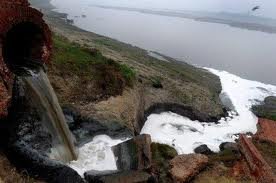ISLAMABAD:
As many as 417 million gallons per day (mgd) of domestic effluent and 80mgd of untreated industrial wastewater are being dumped into the sea and coastal areas of Karachi due to a lack of comprehensive collection and treatment facilities for domestic sewage and industrial wastewater. The entire sewage, after going through different drainage channels including the Lyari and Malir rivers, ultimately goes into the sea. The information to this effect was provided by the Sindh Environmental Protection Agency (SEPA) to the Sindh High Court (SHC) on Wednesday.
This has resulted in polluting the marine environment and posing a threat to marine life. The more dangerous threat of the accumulation of sewage and decomposable solid waste into the marine environment is the decomposition of such organic waste and the production of biogas underneath the silt and sand.
Recent news has alarmed us that some gas has erupted from beneath the silt and sands of Korangi Creek and has taken fire. This mysterious situation of fire eruption all along the Korangi Creek has created doubts among the coastal residents as well as concerned government agencies that some geological deposit of gas exists underneath the silt and sand of the beaches at Korangi. It is informed that this deposit is shallow and not too deep. Thus, it must not be a geological deposit but decomposition of sewage and organic waste into biogas under anaerobic conditions at shallow surface beneath the Korangi Creek sands.
As per the news, the fire at Korangi Creek continues to rage as authorities have temporarily halted firefighting efforts due to extreme heat, fire brigade officials said on Saturday. The officials said that the blaze had erupted during a 1,200-foot-deep excavation in the wee hours of Saturday. Laboratory reports of water samples from the Korangi Creek gas leak have confirmed the presence of underground hydrocarbons (gas) and continuous gas leakage from underground faults or fractures. Chemical results indicate that the gas leak is not the result of biological activity near the surface but may be from thermogenic gas reservoirs located deep below.
According to the preliminary chemical analysis report, the water contains unusually high levels of benzene, toluene, and tetrachloroethane, while o-xylene was also found in concentrations above normal levels. Despite the visible fire and bubbling water in Karachi’s Korangi Creek, the hydrocarbon content in the water samples was found to be below the specified limits. However, the presence of benzene, toluene, and xylene suggests that the contamination likely stems from petroleum hydrocarbons or natural gas condensate. The lab report also found thermogenic signatures, indicating that the methane gas is not the result of biological activity in upper rock layers but a combination of aromatic hydrocarbons and chlorinated solvents, strongly suggesting the presence of deep thermogenic gas. This gas reaching the surface is believed to have caused the fire.
According to the notice, the initial technical assessments, along with independent views from industry experts, suggest that the gas may be biogenic methane, a gas typically formed from the decomposition of organic matter. The company clarified that this discovery is not part of any known natural gas reserves in the region. TPL Properties also noted that, given the nature of the area, it is likely that the gas pocket will naturally dissipate over time, especially if it is left to burn. The company further stated that the test is part of an extensive study conducted with the cooperation of renowned national and international consulting firms.
Biogas is a mixture of various gases that is synthesised as a result of decomposition of organic matter, animal dung, biomass, and other biodegradable material. Its chemical composition is methane (CH₄, 50-70%), carbon dioxide (CO₂, 25-50%), other gases: nitrogen (N₂, less than 5%), hydrogen (H₂, less than 1%), and oxygen (O₂), traces of hydrogen sulfide (H₂S, less than 3%), water vapor (H₂O, less than 10%), and ammonia (NH₃, less than 1%). Methane is inflammable and is purified from biogas into 100% methane that is used as a source of energy and power. The natural gas deposits in Pakistan hidden deep in the earth and discovered by geologists as a source of energy are in fact synthesised in much the same manner as biogas is produced from decomposition of decomposable organic material. It is buried deep in rock and soil crevices, caves and pores. However, biogas is produced on the surface using the same techniques and purified to 100% methane.
The gases emitting from the Korangi Creek and catching fire are nothing but decomposition and other organic solid waste that gets decomposed into biogas stored underneath the sand and silt layers. As sand and silt are porous, the biogas finds space in their layers and is stored. Most of the biogas may also escape into the atmosphere without catching fire, but when a bulk quantity of biogas escapes and ignites, we see the fire disaster continue for days and weeks at Korangi Creek. It is advisable that biogas and bio-methane experts analyse the situation at Korangi Creek and come up with recommendations to manage it. The dumping of untreated sewage into the sea must immediately be stopped, and alternate ways of its anaerobic recycling shall be made to produce biogas as a source of energy and power, along with decomposed manure as a bi-product. We can also earn carbon credits from such a huge source of biogas production through anaerobic decomposition, which is eligible under global carbon credit systems.
THE WRITER HOLDS PHD IN FORESTRY AND IS A CLIMATE CHANGE, FORESTRY AND ENVIRONMENT EXPERT
#Biogas #blaze #exposes #Karachis #waste #crisis



